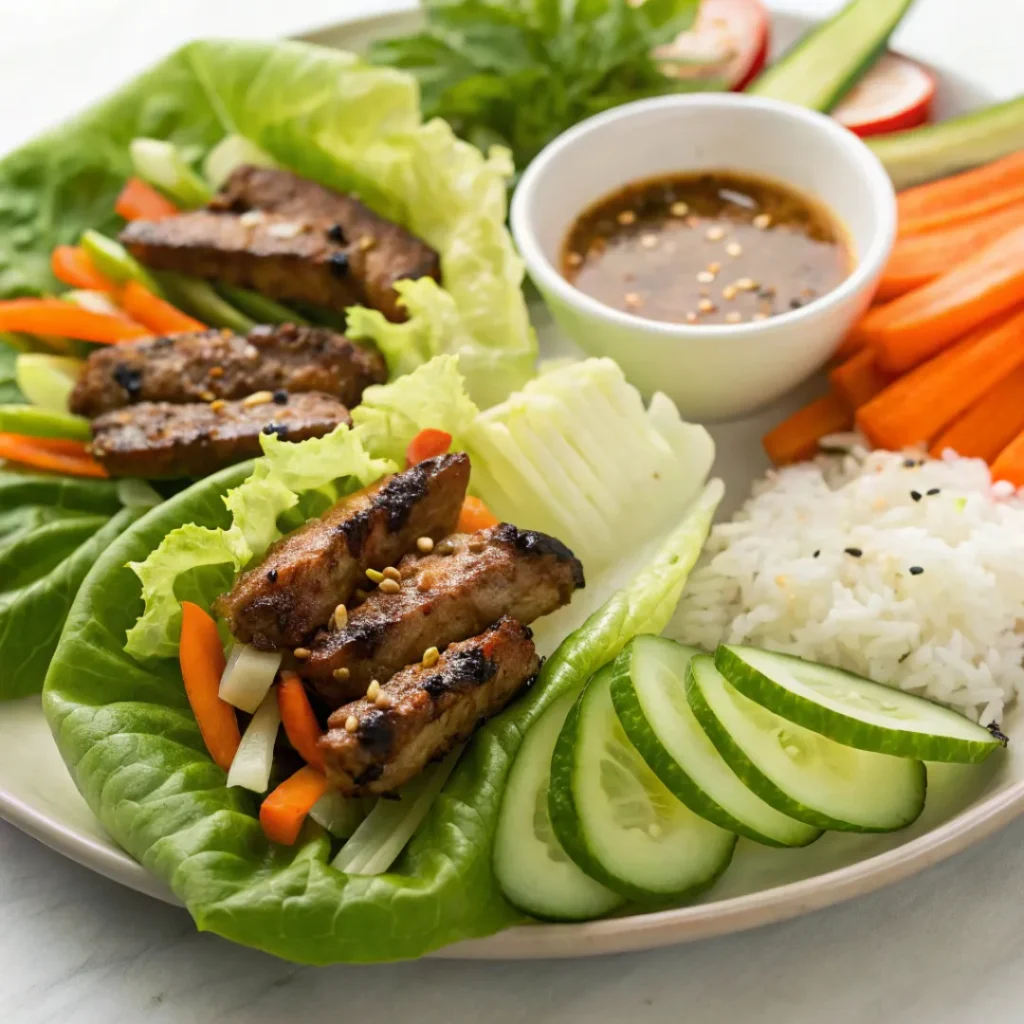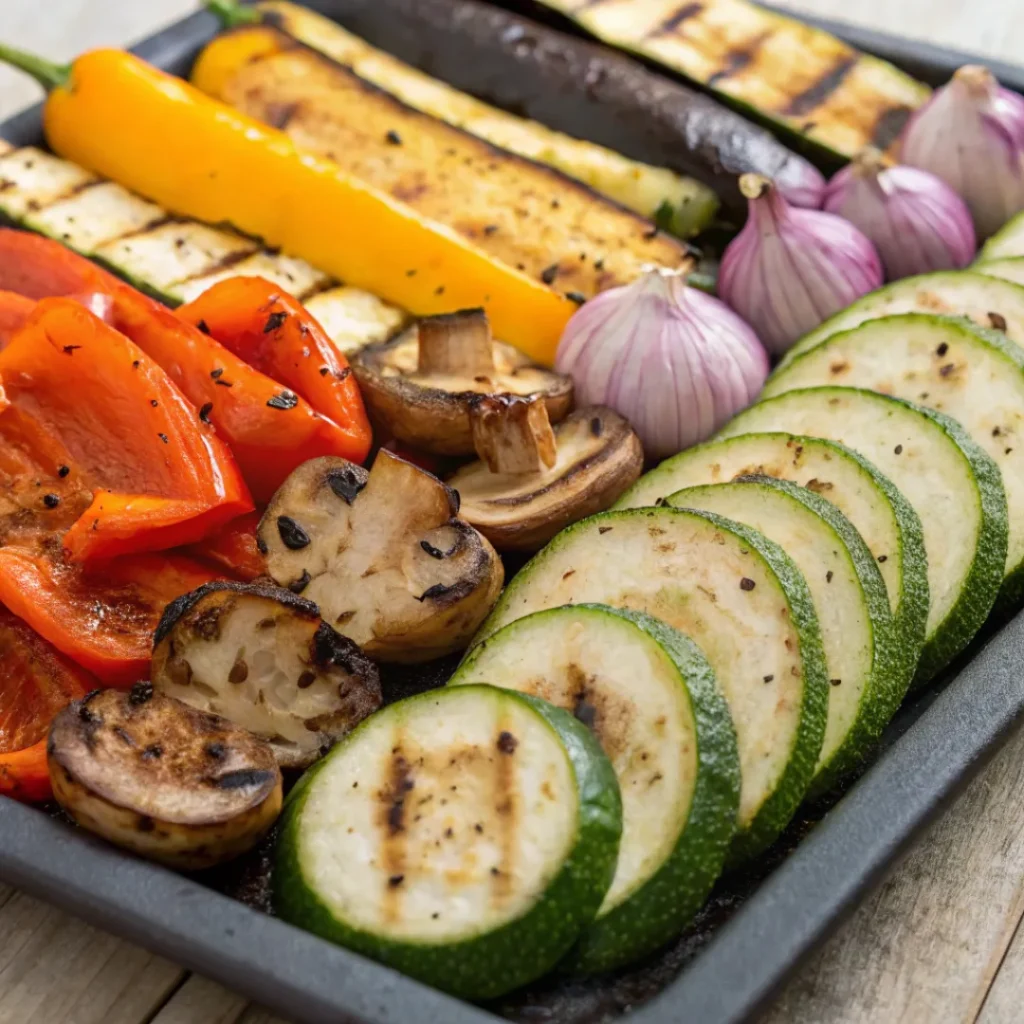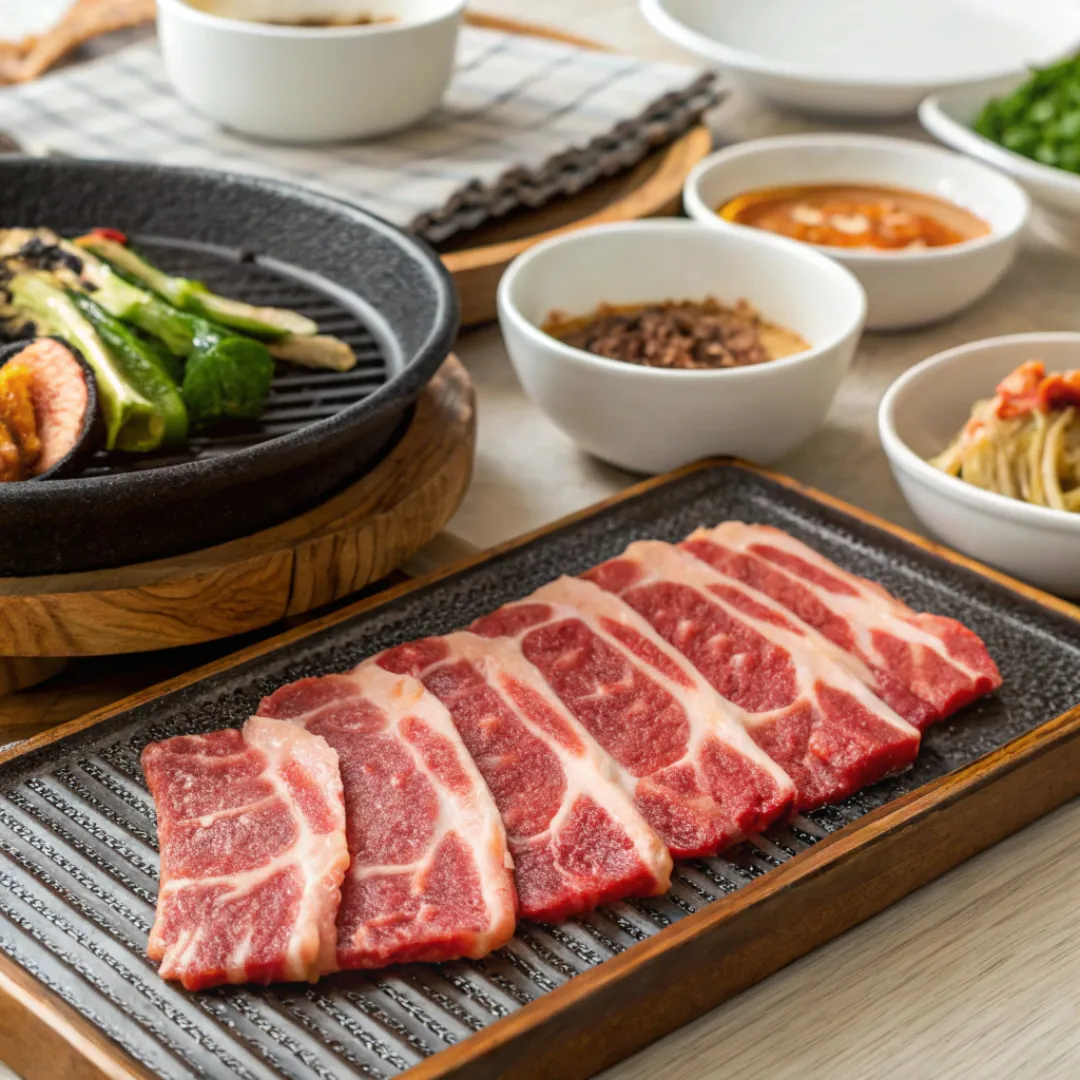Korean BBQ, or K-BBQ, has become a popular culinary experience worldwide. It’s known for its flavorful marinated meats, sizzling grills, and interactive dining style. But what is traditionally served with Korean BBQ? Beyond the delicious beef and chicken that sizzles on the grill, an essential part of the experience is the wide array of side dishes and accompaniments that make Korean BBQ meals truly unique. If you’re interested in trying this experience at home, check out this guide on How to Make Korean BBQ at Home for all the tips you need.
In this comprehensive guide, we’ll explore all the traditional side dishes, sauces, and accompaniments that enhance the flavors of Korean BBQ. From the classic steamed rice to the variety of banchan (Korean side dishes), you’ll learn how these elements come together to create a well-rounded and unforgettable meal.
What Is Traditionally Served With Korean BBQ? The Role of Banchan
When you enjoy a Korean BBQ meal, you’ll quickly notice that it’s more than just the meat. In fact, one of the most important components of a Korean BBQ spread is the banchan. These are small side dishes that come in a variety of flavors, textures, and colors. Moreover, banchan plays a significant role in balancing the rich, savory flavors of grilled meats, and it also provides contrast, variety, and texture to your meal.
Why Banchan Is Essential
Variety
Banchan adds variety to your meal, ensuring that every bite is different.
Balance
It helps balance the rich, smoky flavors of the BBQ meat.
Refreshment
Many banchan dishes are pickled or fermented, which cleanses your palate and enhances the flavors of the meat.
Let’s take a look at some of the most common types of banchan you’ll encounter at a Korean BBQ restaurant.
Kimchi: A Traditional Side Served With Korean BBQ
No Korean BBQ meal is complete without kimchi, one of Korea’s most famous and traditional side dishes. Kimchi is made by fermenting vegetables, typically napa cabbage or radishes, with a mixture of chili pepper, garlic, ginger, and other seasonings. The result is a tangy, spicy, and slightly sour flavor that pairs perfectly with the savory, smoky meat from the grill. To explore more about the different varieties of kimchi you can try, visit Different Types of Kimchi.
Why Kimchi Complements Korean BBQ
Contrast
Its tangy and spicy flavors cut through the richness of the meat, creating a balanced bite.
Digestive Benefits
Kimchi is a fermented food, which means it’s rich in probiotics that aid digestion, especially helpful when eating a heavier meal.
Adds Texture
The crunchiness of kimchi contrasts with the tender, grilled meat.
You might encounter different variations of kimchi at Korean BBQ, such as baechu kimchi (napa cabbage kimchi) or kkakdugi (cubed radish kimchi).
How Rice Complements Korean BBQ: A Traditional Choice
The simplest yet most essential accompaniment to Korean BBQ is steamed white rice. It’s a staple in Korean cuisine and serves as the perfect base to complement the bold flavors of the grilled meat.
For more ideas on pairing beef with other delicious sides, you can check out this guide to perfect pairings for beef bulgogi.
Why Steamed Rice Is Essential
Neutral Flavor
Its mild taste balances the savory, salty flavors of the BBQ meat, making each bite more enjoyable.
Absorbs Juices
Rice absorbs the juices and marinades from the meat, enhancing the overall flavor of the meal.
Versatility
You can combine it with meat, sauces, and banchan to create a flavorful bite.
If you want to try a healthier alternative, you can opt for brown rice or mixed grain rice, but traditional white rice remains the most common choice.
Lettuce Wraps (Ssam) and Fresh Vegetables
One of the most enjoyable aspects of Korean BBQ is creating your own lettuce wraps (ssam) with grilled meat, rice, and dipping sauces. The lettuce adds a refreshing crunch that pairs perfectly with the savory meat. However, if you’re looking to add more variety to your meal, you might also consider trying other breadsticks or crunchy sides. For a unique twist, explore how to eat Grissini breadsticks alongside your Korean BBQ for an added crunchy texture.

How to Make a Perfect Lettuce Wrap:
- Start with a large lettuce leaf (green leaf lettuce or romaine works well).
- Add a piece of grilled meat.
- Include a spoonful of steamed rice.
- Add a dab of ssamjang (a savory dipping sauce made with fermented soybean paste).
- Optionally, add some thinly sliced garlic, green chili peppers, or a bit of kimchi.
- Wrap it up and enjoy!
Lettuce wraps not only provide a fun and interactive way to enjoy your BBQ but also add a fresh, crunchy texture that complements the tender meat.
Ssamjang: The Ultimate Dipping Sauce
Ssamjang is a savory dipping sauce that adds a burst of flavor to Korean BBQ. It’s made from doenjang (fermented soybean paste), gochujang (red chili paste), garlic, green onions, and sesame oil. This sauce pairs perfectly with grilled beef and adds extra depth to each bite.
Since beef bulgogi is one of the most popular meats served with Korean BBQ, you might wonder about the ingredients in its marinade. If you’re curious about whether beef bulgogi contains MSG, you can find out more in this detailed article: Does Beef Bulgogi Have MSG?.
Why Ssamjang Is Essential
Enhances Flavor
It adds a salty, umami-rich taste that complements the savory meat.
Adds Heat
The mild spiciness from the gochujang gives your BBQ an extra kick.
Versatile
You can use ssamjang as a dipping sauce, spread it on lettuce wraps, or add it to rice for extra flavor.
Many Korean BBQ enthusiasts consider ssamjang a must-have condiment for creating the perfect bite.
Pickled Vegetables (Jangajji)
Pickled vegetables, or jangajji, are another traditional side dish served with Korean BBQ. These tangy and crunchy vegetables help cleanse the palate between bites of meat, making each bite as enjoyable as the first.
Popular Pickled Vegetables Include
Pickled radishes
Sweet, tangy, and crunchy, they add a refreshing contrast to the grilled meat.
Pickled cucumbers
These provide a crisp texture and a tangy bite.
Pickled garlic
A bit of pickled garlic can add a flavorful punch to your BBQ wrap.
The acidity of these pickles balances out the rich flavors of the meat, ensuring your taste buds don’t become overwhelmed.
Korean Glass Noodles (Japchae)
Japchae is a popular Korean noodle dish that combines sweet potato starch noodles with stir-fried vegetables like carrots, spinach, mushrooms, and onions. Cooks lightly season the dish with soy sauce and sesame oil, giving it a flavor that’s both savory and slightly sweet.
Why Japchae Goes Well with Korean BBQ
Chewy Texture
The chewy noodles contrast nicely with the tender meat.
Flavorful and Light
It offers a savory flavor that doesn’t overpower the meat.
Nutrient-Rich
The inclusion of various vegetables adds color and nutrition to your BBQ meal.
Japchae is often served as a side dish but can also be enjoyed on its own.
Gyeranjjim (Steamed Egg Custard)
Gyeranjjim is a light and fluffy steamed egg custard that tastes both soft and savory. To prepare it, cooks whisk eggs with water or broth, then steam the mixture until it reaches a creamy, custard-like consistency.
Why Gyeranjjim Complements Korean BBQ
Mild Flavor
Its gentle flavor balances out the strong, smoky taste of grilled meat.
Soft Texture
The smooth, silky texture offers a contrast to the meat’s chewiness.
Comforting Dish
It provides a comforting element that balances the meal’s overall flavor.
Gyeranjjim is typically served in a hot stone bowl, ensuring it stays warm throughout your BBQ meal.
Grilled Vegetables
Adding grilled vegetables to your Korean BBQ spread is a great way to include variety and enhance the meal’s nutritional value. Common vegetables for grilling include zucchini, mushrooms, bell peppers, onions, and eggplant.

Benefits of Grilled Vegetables
Healthy Option
They provide essential nutrients and vitamins, making your meal more balanced.
Flavorful and Smoky
The grilling process enhances the natural sweetness and adds a smoky flavor that pairs well with the meat.
Adds Texture
The slight crunch of grilled vegetables complements the tenderness of the BBQ meat.
These vegetables can be grilled alongside your meat, allowing them to soak up the delicious BBQ flavors.
Rice Paper Wraps (Vietnamese Style)
While not strictly traditional, rice paper wraps have nonetheless become a popular addition to Korean BBQ. They offer a light and refreshing way to enjoy the grilled meat, and their transparent appearance adds a unique texture to your meal.
How to Use Rice Paper Wraps:
- Soak the rice paper in warm water until soft.
- Place a piece of BBQ meat, some rice, and a bit of banchan in the center.
- Roll it up and enjoy!
Rice paper wraps are a fun and modern twist on the Korean BBQ experience, allowing you to customize each bite.
Frequently Asked Questions
What sides are usually served with Korean BBQ?
The most common sides served with Korean BBQ typically include steamed white rice, kimchi, and lettuce wraps (ssam). In addition, you’ll often find a variety of banchan such as japchae, pickled vegetables, and gyeranjjim (steamed egg custard).
Do you always need to have rice with Korean BBQ?
Although rice is a staple, you can enjoy Korean BBQ without it. Many people prefer using lettuce wraps or rice paper wraps instead.
What dipping sauces go well with Korean BBQ?
The most popular dipping sauce for Korean BBQ is ssamjang, a savory blend of fermented soybean paste and chili paste. Gochujang (Korean chili paste) is another popular option for those who like extra spice.
Can I make Korean BBQ at home without all the side dishes?
Yes, you can! However, including a few key sides like kimchi, steamed rice, and lettuce wraps will enhance the flavors and make your meal feel more authentic.
What vegetables are commonly grilled with Korean BBQ?
Common vegetables include zucchini, mushrooms, onions, bell peppers, and eggplant. These add a smoky flavor and balance to the meal.
Conclusion
Korean BBQ is more than just grilled meat—it’s truly a complete culinary experience. What’s more, it becomes even richer with a variety of traditional side dishes, sauces, and accompaniments. For example, the must-have steamed white rice and crunchy kimchi, along with the interactive lettuce wraps (ssam) and flavorful ssamjang, add depth and excitement to the meal. Furthermore, these sides are not only delicious but also help balance the rich, savory flavors of the BBQ beef, thus enhancing the overall experience.

